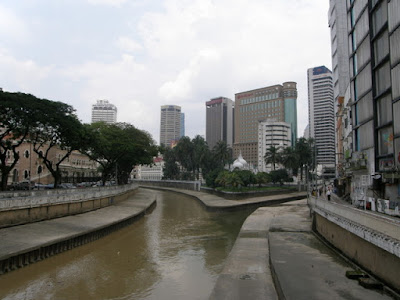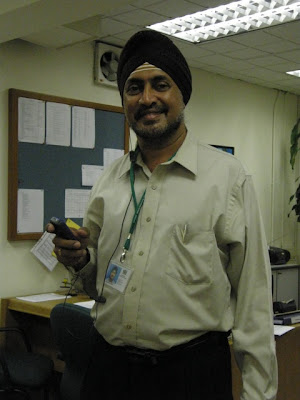Kuala Lumpur - old and new.
These new apartment blocks are typical of those springing up all over the city.
However, the infrastructure is not developing at the same rapid rate. This and the next photo show the consequences of inadequate storm drains during a late afternoon cloudburst.

But on the outskirts of the city many local pockets of low-rise housing continue to hold their own.
Downtown, a few examples of Colonial elegance still survive. Mostly former public buildings.


And the city continues to build lavish public edifices...
The National Mosque The Court House
The Court House The National Monument.
The National Monument.
While close to the "Muddy Banks" where Kuala Lumpur began ...

However, the infrastructure is not developing at the same rapid rate. This and the next photo show the consequences of inadequate storm drains during a late afternoon cloudburst.


But on the outskirts of the city many local pockets of low-rise housing continue to hold their own.

Downtown, a few examples of Colonial elegance still survive. Mostly former public buildings.



And the city continues to build lavish public edifices...
The National Mosque
 The Court House
The Court House The National Monument.
The National Monument.
While close to the "Muddy Banks" where Kuala Lumpur began ...

A wonderful diversity of ethnicity and religions.
 Hindu family at Batu Caves.
Hindu family at Batu Caves.The baby's head has been shaved and painted with clay to thank the gods for her safe arrival in this world.
 Muslim children just home from school.
Muslim children just home from school. Skilled Malaysian worker at the Royal Selangor Pewter Factory.
Skilled Malaysian worker at the Royal Selangor Pewter Factory. Female Muslim market inspectors in the China Town district.
Female Muslim market inspectors in the China Town district. Construction workers (mostly Indonesian or Tamils.)
Construction workers (mostly Indonesian or Tamils.)waiting for transport home after a long day's work.
 Chinese Dragon dancers entertain China Town shoppers.
Chinese Dragon dancers entertain China Town shoppers. While Chinese Lion dancers bringing good fortune to a local supermarket ....
While Chinese Lion dancers bringing good fortune to a local supermarket .... Loudly accompanied by the beating of drums and cymbals.
Loudly accompanied by the beating of drums and cymbals.Thousands of motorcycles.





































